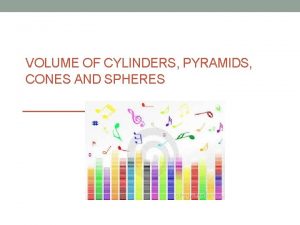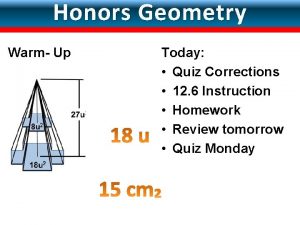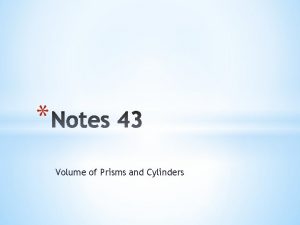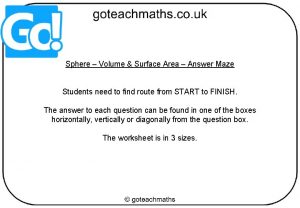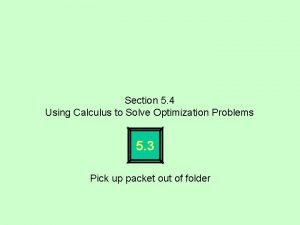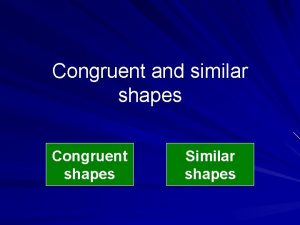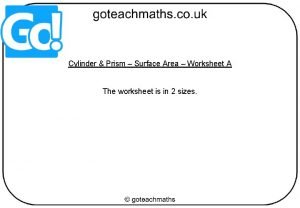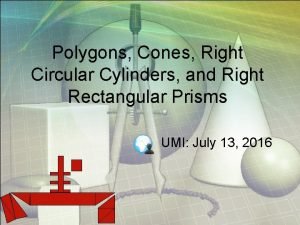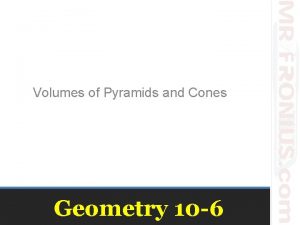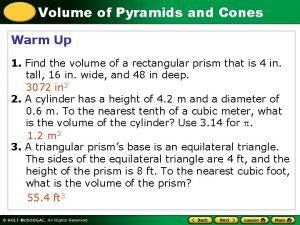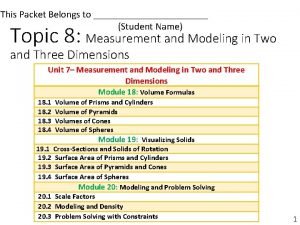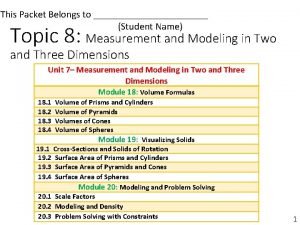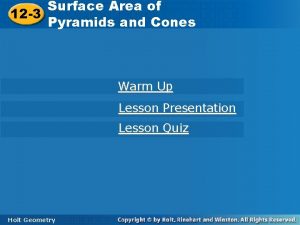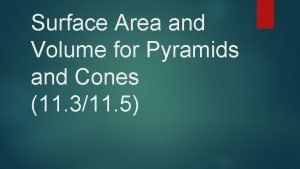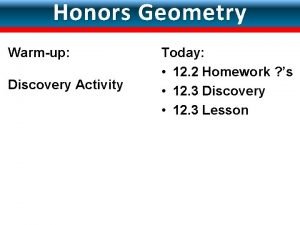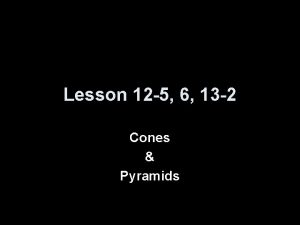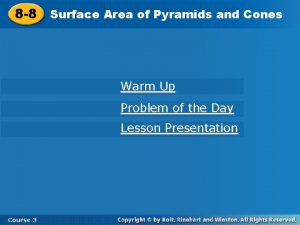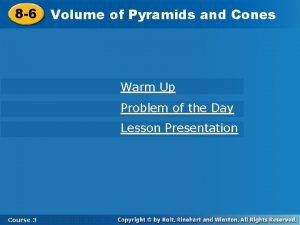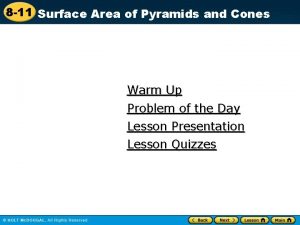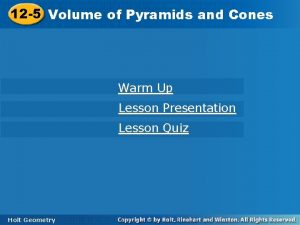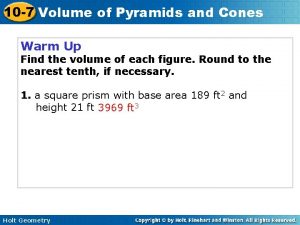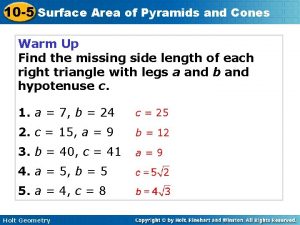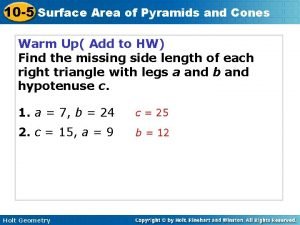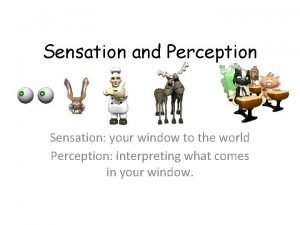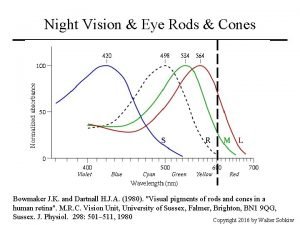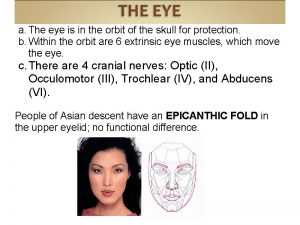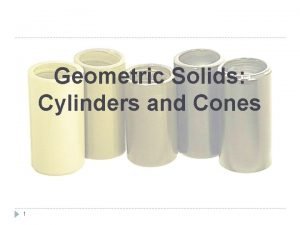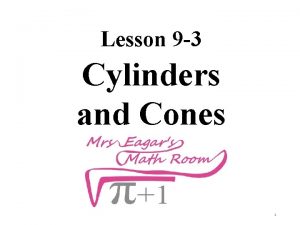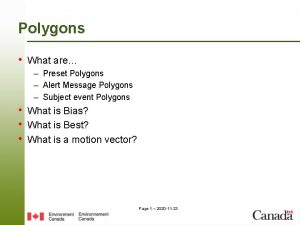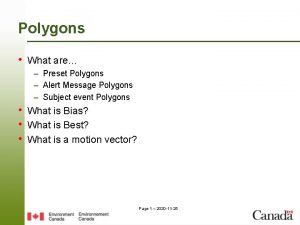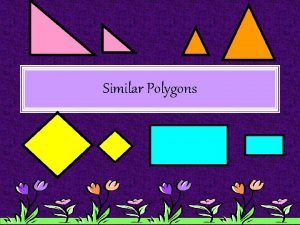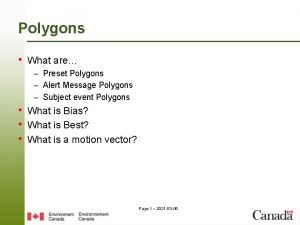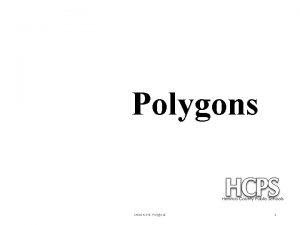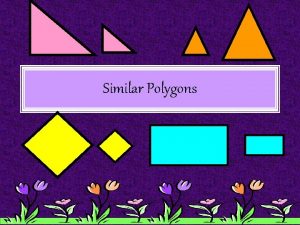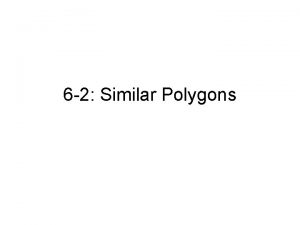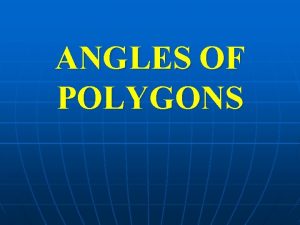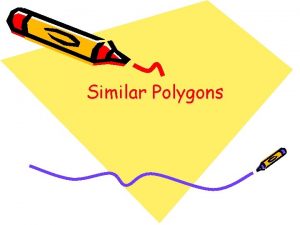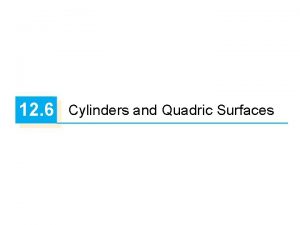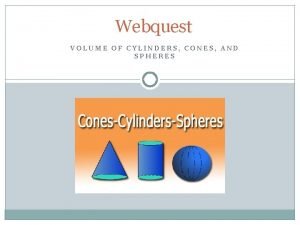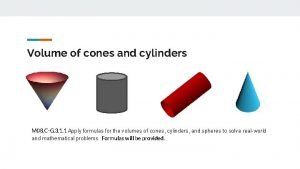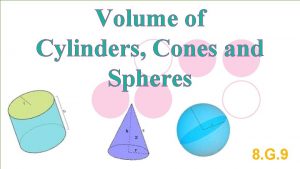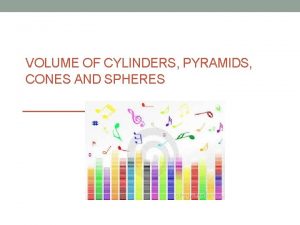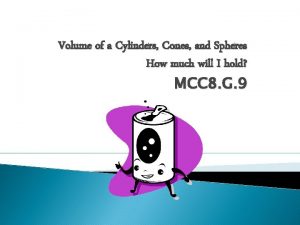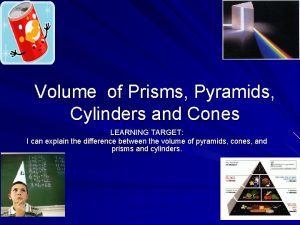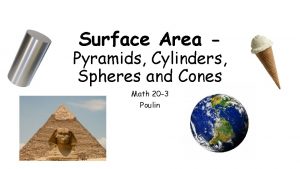Polygons Cones Right Circular Cylinders and Right Rectangular


































- Slides: 34

Polygons, Cones, Right Circular Cylinders, and Right Rectangular Prisms UMI: July 13, 2016

Polygons are simple closed curves with sides that are only segments. • Simple: does not intersect itself • Closed: Curve can be drawn starting and stopping at the same point. • Segment: Straight line

Polygons and Non-polygons.

Perimeter of Polygons The perimeter of Polygons is the sum of lengths of its sides. Practice 1: What is the perimeter of the rectangle? Solution: Perimeter = sum of the lengths of its sides = 7. 5 + 4. 5 + 7. 5 + 4. 5 = 24

Practice 2: What is the perimeter of This polygon? Solution : Perimeter of the polygon = sum of the lengths of sides = 2 + 3 + 2 +3 + 4 + 2 + 8 = 36

Practice 3: Graph the polygon ABCDEF, which has vertices A(-3, 3) B(1, 3) C(1, 1) D(4, 1) E(4, -3) F(-3, -3); What is the perimeter of the polygon, ABCDEF? Solution : Perimeter of the polygon = sum of the lengths of sides = 4 + 2 + 3 + 4 + 7 + 6 = 26

Area of Polygons The area of a polygon is the number of square units inside that polygon. Example: Find the area of the following polygons

The Area of a Rectangle Put the shape on a grid and count the number of squares The rectangle has an area of 15. If each square was 1 cm on a side, then the area would be 15 cm 2 (15 square cm) The formula is: Area = w × h w = width, h = height The width is 5, and the height is 3, so we know w = 5 and h = 3: Area = 5 × 3 = 15

The Area of a Triangle

The Area of Popular Polygons

Example: Sam cuts grass at $0. 10 per square meter. How much does Sam earn cutting this area: Solution : Let's break the area into two parts: Part A is a square: Area of A = a 2 = 20 m × 20 m = 400 m 2 Part B is a triangle. Viewed sideways it has a base of 20 m and a height of 14 m. Area of B = ½b × h = ½ × 20 m × 14 m = 140 m 2 Area = Area of A + Area of B = 400 m 2 + 140 m 2 = 540 m 2 Sam earns = $0. 10 × 540 m 2 = $54

Practice 1: What is the area of the trapezoid? Solution : Use the formula Area = ½(a+b) × h with a = distance across the top = 3. 5 b = distance across the base = 7. 5 h = vertical height = 4 Area =½(3. 5 + 7. 5) × 4 = 5. 5 × 4 = 22

Practice 2: What is the area of the octagon? Solution : Surround the octagon with a square Now subtract the 4 little triangles: The area of the four triangles = 4 × ½ × 2 = 8 So the area of the octagon = =49 − 8 = 41

Cones A Cone is a solid that has a circular base and a single vertex. Right Cone: If the vertex is over the center of the base, it is called a right cone. Oblique Cone: is one where the vertex is not over the center of the circular base.


Surface Area of Cones A Cone is a solid that has a circular base and a single vertex.

Surface Area of Cones - Derivation A cone can be broken down into a circular base and the top sloping part. The Surface area is the sum of these two areas. Base: The base is a simple circle, So its area is given by; The Top: If we were to cut the cone up one side along the red line and roll it out flat, it would look something like the shaded pie-shaped section below

Surface Area of Cones - Derivation This shaded section is actually part of a larger circle that has a radius of s, the slant height of the cone. We are able to find the area of sector. Which is a proportional the area of the circle.

Volume of Cones The volume of a cone is given by the formula There two ways to derivative the formula 1. Experiment 2. Use of Calculus

Practice 1: The diagram shows a cone of height 24 cm and base diameter 14 cm. What is its volume? Solution : Given diameter = 14 cm, so r = 7 cm and h = 24 cm, use the formula

Practice 2: The diagram shows a cone of height 5 cm and base radius 12 cm. What is the total surface area of the cone? Solution :

Right Circular Cylinders A circular cylinder is a closed solid that has two parallel circular bases connected by a curved surface. Right Circular Cylinders: When the two circular bases are exactly over each other and the axis is a right angles to the base, this is a called a 'right circular cylinder'.

Surface Area of the Right Circular Cylinders

Derivation The surface area of a cylinder can be found by breaking it down into three parts: The two circles that make up the ends of the cylinder. The side of the cylinder, which when "unrolled" is a rectangle 1. 2.

Derivation

Volume of the Right Circular Cylinders

Practice 1: The diagram shows a cylinder of diameter 20 units and height 9 units. Find the surface area of the cylinder. Solution :

Practice 2: The diagram shows a cylinder of height 4 units and diameter 4 units. What is its volume? Solution :

Right Rectangular Prisms A prism is a solid that has two faces that are parallel and congruent. These are called the bases of the prism. Right Rectangular Prisms 1. The bases are rectangles 2. The bases are exactly one above the other. This means that lines joining corresponding points on each base are perpendicular to the bases

Surface Area of the Right Rectangular Prism Which can be shortened to

Volume of the Right Rectangular Prism

Practice 1: Find the surface area and the volume of this right rectangular prism Solution :

Practice 2: Find the surface area and the volume of this right rectangular prism Solution :

Thank You References: 1. A problem solving approach to mathematics for elementary school teachers by Billstein, Libeskind, Lott 2. Math is Fun : https: //www. mathsisfun. com/ 3. Math Open Reference: http: //www. mathopenref. com/
 Finding the volume of cylinders pyramids cones and spheres
Finding the volume of cylinders pyramids cones and spheres Unit 6 lesson 6 surface areas and volumes of spheres
Unit 6 lesson 6 surface areas and volumes of spheres Find the volume of each figure
Find the volume of each figure Volume and surface area of prisms maze worksheet
Volume and surface area of prisms maze worksheet Cone volume ratio
Cone volume ratio Consider all right circular cylinders for which the sum
Consider all right circular cylinders for which the sum Right product right place right time right price
Right product right place right time right price Family time
Family time Differentiate similar polygons from congruent polygons
Differentiate similar polygons from congruent polygons The right man on the right place at the right time
The right man on the right place at the right time The hair form should be in proportion to the
The hair form should be in proportion to the Prism volume and surface area worksheet
Prism volume and surface area worksheet Right rectangular cylinder
Right rectangular cylinder Practice 10-6 volumes of pyramids and cones
Practice 10-6 volumes of pyramids and cones Volume of pyramids and cones
Volume of pyramids and cones Practice 11-3 surface areas of pyramids and cones
Practice 11-3 surface areas of pyramids and cones Lesson 19-3 surface area of pyramids and cones
Lesson 19-3 surface area of pyramids and cones Pyramid volume
Pyramid volume 12-3 surface areas of pyramids and cones
12-3 surface areas of pyramids and cones Area of the cone
Area of the cone Surface area of pyramids and cones worksheet
Surface area of pyramids and cones worksheet Lesson 11-3 surface areas of pyramids and cones
Lesson 11-3 surface areas of pyramids and cones Lesson 12-5 volumes of pyramids and cones
Lesson 12-5 volumes of pyramids and cones Surface area of pyramids and cones
Surface area of pyramids and cones How to find the volume of pyramids and cones
How to find the volume of pyramids and cones 11-3 additional practice pyramids and cones
11-3 additional practice pyramids and cones Lesson 12-5 volumes of pyramids and cones
Lesson 12-5 volumes of pyramids and cones 11-3 volumes of pyramids and cones
11-3 volumes of pyramids and cones 10-7 volume of pyramids and cones
10-7 volume of pyramids and cones 10-7 volume of pyramids and cones answer key
10-7 volume of pyramids and cones answer key Surface area of pyramids and cones
Surface area of pyramids and cones 10-5 surface area of pyramids and cones
10-5 surface area of pyramids and cones Alex tickles his brother by stroking adjacent
Alex tickles his brother by stroking adjacent Rods and cones
Rods and cones Cones and color vision
Cones and color vision
